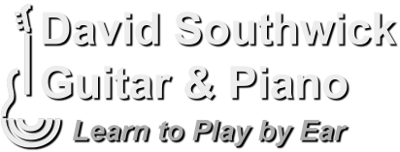Scales
Tips & TricksThere are many tips and tricks to learning to play lead and learning to improvise. Here are some of the ones that I use:
Use Backing Tracks
With Youtube, you can find a host of backing tracks in various styles and keys. Find ones you like and begin playing along with them, using any or all of the tips below.
Alternate Picking
When I first started learning scales, I was taught to pick up and down on alternating notes. However, Troy Stetina teaches students to pluck down on all beats, until you get to incorporating sixteenth beats (1 e & a 2 e & a 3 e & a 4 e & a). Once you are incorporating sixteenth beats then he recommends alternate picking: downs on all numbered and and beats, and ups on all other beats.
Learn Inflection Techniques
Unless you want to strictly use a flat-picking approach, I would recommend working/mastering on the following techniques: vibrato, hammer-ons, pull-offs, slides, and bends.
Vibrato is one of the most important tools. Without it, your lead will tend to sound bland. Use vibrato especially when hanging on a note. Vibrato will help bring some of the sustain out of the note. First bend the string up (or down) and back, NOT up and down, and repeat for the duration of the note.
Hammer-ons, pull-offs, slides and bends are other important tools for the lead guitarist. They give a nice feel to the flow of notes. Additionally, each of them are used to lead into the target pitch of the desired note. Bends also give the ability at a slower or higher rate to pass through notes, which give them a type of whining characteristic.
Below are links to Troy Stetina’s Metal Lead Guitar Volumes 1 and 2. Each of them come with a CD. He covers all these tools and more. I highly recommend them.
[amazon_link asins=’0793509602,0793509610′ template=’ProductGrid’ store=’davsousguicho-20′ marketplace=’US’ link_id=’e9125bb7-4e73-11e8-823c-51abb01b1727′]
Use Major and Minor Scales Together
Use a major key with its relative minor. If a song is in the key of G, don’t just rely on the G major pentatonic scale, incorporate the Em pentatonic scale. The following go together because of they are relative chords: C and Am; D and Bm; E and C#m; A and F#m; etc.
Use the different patterns of scales to increase the use of more of the fretboard. Flow in and out of the major and minor scales.
Improv Ideas
There are many ways to gain inspiration for improvisation. First, learn tools, lead cliches, etc.
Rhythm. In Metal Lead Guitar, Volume 1, Troy Stetina recommends creating certain rhythms, then changing the notes for the rhythm you’ve created.
Melody. Learning to play the melody of a song by ear is excellent practice. A good lead guitarist should be able to transfer a melody in their head to the fretboard by ear. Many great solos take the melody as a starting point, and then veer off of the melody to create some depth and dimension to the solo. It’s not a bad idea to play part of the melody, then break off from it, come back to it, and veer off again.
Experiment with a Limited Number of Notes. Experiment with just three notes from your scale to see how many variations you can come up with by changing the rhythm, changing the frequency of the notes, and the order of playing them. Create multiple expressions with just 3 or 4 notes.
Arpeggios
Arpeggios are using chord shapes, but playing notes one at a time without allowing the notes to overlap. With these, we incorporate a technique called sweep picking. I would recommend Paul Hanson’s “Arpeggios for the Lead Guitarist” for an introduction to arpeggios.
Modes
You can’t really get into playing lead guitar without hearing about ‘modes’. Modes take the same notes from the major scale, and change the starting and ending notes. This approach changes the tone of the scale you are working from.
Check out this book, Scales and Modes for Guitar (with CD):
[amazon_link asins=’0882847201′ template=’ProductGrid’ store=’davsousguicho-20′ marketplace=’US’ link_id=’2edb5901-4e74-11e8-8548-d9423dbbab4b’]
The mode names are Ionian, Dorian, Phrygian, Lydian, Mixolydian, Aeolian, and Locrian, and they are built off of the numbered notes of a major scale:1, 2, 3, 4, 5, 6 and 7 respectively. Look at the following chart to see how these modes are built from the key of C:
1 C Ionian: C D E F G A B C 2 D Dorian: D E F G A B C D 3 E Phrygian: E F G A B C D E 4 F Lydian: F G A B C D E F 5 G Mixolydian: G A B C D E F G 6 A Aeolian: A B C D E F G A 7 B Locrian: B C D E F G A B
These are the modes built off of the C Major Scale. When you start on a different note than C, the mode changes, though the mode still keeps all of the notes of the key of C.
Thus, if we wanted the E Dorian mode, we would find the key that has E as the second note, and build the mode from the notes in that key. E is the second note in the key of D, therefore, the E Dorian mode is E F# G A B C# D E.


Hi David, thanks for sharing all these great tips! Really appreciate your effort and great work! I play simple chords to lead worship in my church service. May the Lord bless you!
Thanks Kristy! I appreciate the kind remarks! Jesus bless you as well!
Hi,
A quick example for this would break a hardshell for me please.
Use a major key with its relative minor. If a song is in the key of G, don’t just rely on the G major pentatonic scale, incorporate the Em pentatonic scale. The following go together because of they are relative chords: C and Am; D and Bm; E and C#m; A and F#m; etc.
So Gmajor -G A B C D E F# G — if i play a song in G, C and D and Am,Bm and Em rather than playing a solo in G – G A B D E (for solo -g major pentatonic scale) should I used
em pentatonic scale – E G A B D—( should this be a solo-this part I’m confused)?
Can I get some example for this like a song or atleast some tab for this type so that i can crack down all the other stuff.
Thanks,
Dilip
Thanks Dilip for your comments/question. I use multiple licks and phrases from either the major pentatonic scale, or from the minor pentatonic from the keys relative minor. Troy Stetina has some great instructional books that employ common licks and phrasings.
I will try to send you some samples presently via email. If you don’t hear from me contact me back here. Thanks.
Thanks for all the knowledge!
One question though, aren’t the major pentatonic and its relative minor pentatonic the exact same scales? Like G major pentatonic and Em pentatonic:
G,A,B,D,E
E,G,A,B,D
I am realizing the only difference is the order, so does that mean you can swap out the root, 4th and 5th etc.?
Thanks for your comments! Yes those scales are the same. The only thing that changes is which note you start with. I often use them interchangeably. When improvising, I sometimes play parts of the pentatonic scale of whatever chord is being played in the measure. If a D chord is played I’ll play notes from the D major pentatonic scale. If an Am is being played I’ll play riffs from the A minor pentatonic scale. Thus if I’m playing a song that is in the key of G I might play riffs through 3 different major pentatonic scales (G, C and D) and riffs through 3 minor pentatonic scales (Em, Am and Bm).